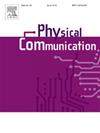Dual-path residual attention network for efficient channel estimation in RIS-assisted communication systems
IF 2
4区 计算机科学
Q3 ENGINEERING, ELECTRICAL & ELECTRONIC
引用次数: 0
Abstract
Channel estimation of reconfigurable intelligent surface-aided multi-user communication (RIS-MUC) systems is one of the key tasks for expanding network coverage and improving signal transmission quality. However, such a system typically involves cascaded channels with complex statistical distributions, making channel estimation more challenging. Existing channel estimation methods face the dual challenges of high pilot overhead and limited estimation accuracy. To address the above problems, this paper proposes an efficient channel estimation framework that integrates deep learning and two-timescale channel estimation to minimize pilot overhead and improve estimation accuracy. First, this paper models the channel estimation problem as a denoising problem. Then, a denoising neural network based on the convolutional neural network (CNN) and residual structures is designed, which is named the dual-path residual attention network (DPRAN). The network leverages parallel residual structures and spatial attention mechanisms to extract spatial features from the noisy channel matrix for channel recovery. Experimental results reveal that the proposed method can achieve higher channel estimation accuracy under different channel conditions and system configurations.
求助全文
约1分钟内获得全文
求助全文
来源期刊

Physical Communication
ENGINEERING, ELECTRICAL & ELECTRONICTELECO-TELECOMMUNICATIONS
CiteScore
5.00
自引率
9.10%
发文量
212
审稿时长
55 days
期刊介绍:
PHYCOM: Physical Communication is an international and archival journal providing complete coverage of all topics of interest to those involved in all aspects of physical layer communications. Theoretical research contributions presenting new techniques, concepts or analyses, applied contributions reporting on experiences and experiments, and tutorials are published.
Topics of interest include but are not limited to:
Physical layer issues of Wireless Local Area Networks, WiMAX, Wireless Mesh Networks, Sensor and Ad Hoc Networks, PCS Systems; Radio access protocols and algorithms for the physical layer; Spread Spectrum Communications; Channel Modeling; Detection and Estimation; Modulation and Coding; Multiplexing and Carrier Techniques; Broadband Wireless Communications; Wireless Personal Communications; Multi-user Detection; Signal Separation and Interference rejection: Multimedia Communications over Wireless; DSP Applications to Wireless Systems; Experimental and Prototype Results; Multiple Access Techniques; Space-time Processing; Synchronization Techniques; Error Control Techniques; Cryptography; Software Radios; Tracking; Resource Allocation and Inference Management; Multi-rate and Multi-carrier Communications; Cross layer Design and Optimization; Propagation and Channel Characterization; OFDM Systems; MIMO Systems; Ultra-Wideband Communications; Cognitive Radio System Architectures; Platforms and Hardware Implementations for the Support of Cognitive, Radio Systems; Cognitive Radio Resource Management and Dynamic Spectrum Sharing.
 求助内容:
求助内容: 应助结果提醒方式:
应助结果提醒方式:


